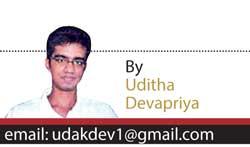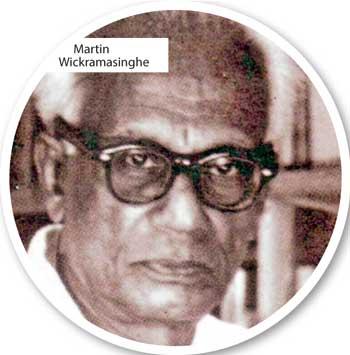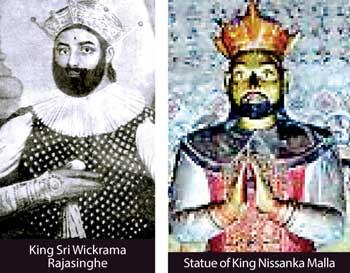Reply To:
Name - Reply Comment
Last Updated : 2024-04-19 11:04:00
 In his influential essay “The People of the Lion”, Professor R. A. L. H. Gunawardena argues for a national historiography devoid of Western ideology. He does not refute or call for the doing away of the latter altogether, but suggests rather that it has intruded on studies of group identities to such an extent that the history we think we unearth is very different to the history that was actually there. By imputing terms like “race” (a 16th century European concept) and “Aryan” (which gained prominence with attempts by orientalist scholars of the 18th and 19th centuries to draw parallels between Indo-Lankan and European languages), we are, as he points out, “presenting a view of the past moulded by contemporary ideology.”
In his influential essay “The People of the Lion”, Professor R. A. L. H. Gunawardena argues for a national historiography devoid of Western ideology. He does not refute or call for the doing away of the latter altogether, but suggests rather that it has intruded on studies of group identities to such an extent that the history we think we unearth is very different to the history that was actually there. By imputing terms like “race” (a 16th century European concept) and “Aryan” (which gained prominence with attempts by orientalist scholars of the 18th and 19th centuries to draw parallels between Indo-Lankan and European languages), we are, as he points out, “presenting a view of the past moulded by contemporary ideology.”
What we know, from the inscriptions, the historical chronicles, and the retold narratives, is that ancient Sri Lankan society was not rooted in the concept of race the way the reconstruction of its history is today. Group ideology was largely determined by the clans and tribes that settled/migrated from other civilisations. Fa-Hsien was (as Professor K. M. de Silva wittily observes) not being very helpful when he wrote that the country was originally inhabited by yaksas and nagas who traded with merchants simply because human settlements here predate both those clans.
 The first local hunter-gatherers lacked iron implements, which is probably how they came to be colonised by the Indo-Aryan Iron Age settlers. The hunter-gatherers are said to have approximated to the Veddhas, the Iron Age settlers to Sinhala people. The question of whether the former were an agricultural people is debated: the Valahassa Jatakaya, for instance, tells us of she-yakkas devouring food from wrecked ships and enslaving, if not tormenting, the sailors aboard them, while the Mahavamsa relates an episode of Vijaya coming across these ships after his encounter with Kuveni.
The first local hunter-gatherers lacked iron implements, which is probably how they came to be colonised by the Indo-Aryan Iron Age settlers. The hunter-gatherers are said to have approximated to the Veddhas, the Iron Age settlers to Sinhala people. The question of whether the former were an agricultural people is debated: the Valahassa Jatakaya, for instance, tells us of she-yakkas devouring food from wrecked ships and enslaving, if not tormenting, the sailors aboard them, while the Mahavamsa relates an episode of Vijaya coming across these ships after his encounter with Kuveni.
These narratives divided not just scholars, but even linguists: Martin Wickramasinghe in Sinhala Sahithyaye Nageema argued that the existence of these ships indicated that there was no advanced pre-Vijayan agricultural society, while the pioneers of the Hela Havula, especially Munidasa Cumaratunga and Raphael Tennekoon, contended that Kuveni being engaged with a spinning wheel at the time of Vijaya’s entrance showed that society was advanced prior to the Indo-Aryan colonisation.
The issue is that these texts were occupied more with idealising a religious sect or monarch than presenting a view of life as it was lived. If they presented such a view, which they occasionally did, it was in a rather hazy, fragmentary manner.
The Brahmi inscriptions form among the most concrete evidence we have for the kind of civilisation that developed after the Indo-Aryan migration. These inscriptions come to us from the 7th century BCE onwards, and they were made by the upper classes of their time. We have Yaksha, Naga, Vedic, and Puranic inscriptions, and they allude to the status of their authors, their families, and their occupations.
The Puranic inscriptions tell us of pre-Buddhist religious cults which revolved around the Mother Goddess, Vishnu, and Siva, which lends credence to G. P. Malalasekara’s view that Vijaya was tolerant of all faiths. Evidence from the inscriptions of Jain and Tamil settlements, as well as settlements by, inter alia, Kabojas (Kashmiris), Moriyas (Mauryas), and Baratas (merchants or, as per Paranavithana, nobles) tells us that we were a multi-racial country, at least in terms of “contemporary ideology.”
But these clans were so disparate that they were unable to develop a cohesive identity. They identified themselves with a totem: Moriyas had the peacock, Lambakannas the hare, Kulingas the shrike, Tarachchas the hyena. This continued into the evolution of group identities later on, as evidenced by the fact of the lion and the tiger: the former became the standard of the “Sinhala” people, whereas the latter was adopted by the Nayakkar kings of Kandy who ruled over these same “Sinhala” people.
In ancient Sri Lankan society the ideology of the State was expressed through the identity of the ruling class. What this meant was that there was no overriding racial consciousness as such, so much so that, for instance, when Dutugemunu went to war we had, not Sinhalas fighting Tamils, but one dynasty battling another.
“Sinhala Buddhism” was most probably not rooted in Sri Lankan society the way it has now, and if it was, the needs of the Buddha Sasana were considered as being more important than racial or national-level considerations: the author of the Mahavamsa, for instance, has Dutugemunu say that he’s fighting not for the sovereignty of the land but the preservation of the Order. The vague status of Buddhism can be gleaned from the fact that it was accorded a foremost position even by external forces, at least in the case of Elara; the Mahavamsa valorises him as a just ruler, tainted only by his “false beliefs.” In contrast, after the 10th century AD we see a heightening of anti-Buddhist and anti-Jain sentiment among South Indian invaders.
H. L. Seneviratne, in an otherwise eloquent essay on the topic (“Buddhism, Identity, and Conflict”), argues that Sri Lankan society was never the ekeeya rajya it is touted as by nationalists. He is correct in theory, wrong in substance: the Westphalian notion of sovereignty was alien to the rulers of the land and thus simply not applicable. To be sure, “particularism” persisted in Anuradhapura and the absence of a proper central administrative structure in Polonnaruwa, as K. M. de Silva points out, contributed to the disintegration of the rajya, but at the same time what must be borne in mind is that group consciousness permeated society even at the level of a divided State. In the aftermath of the invasion by Kalinga Magha in the Polonnaruwa era, we see a strengthening of a local Buddhist identity in response to the threat of fragmentation of the State, ekeeya or otherwise. It was a classic case of hostility by an invading force giving rise to a group identity. Nissanka Malla’s decree, that only a Buddhist could rule the land, must be seen in the light of Magha’s later campaigns of destruction. The fact that this “Buddhist king” himself is said to have come from the Kalinga dynasty speaks volumes about the amorphous nature of group identity formation. To be sure, there was opposition to an ethnic other occupying the throne, but we must understand that it was never the kind of opposition that Sinhala Buddhist nationalists project towards the possibility of an ethnic other presiding over Sri Lanka now. When Bhuvanekabahu VI faced an uprising in the South, it was later painted as an uprising against a ruler of Malayali blood; this did not stop chroniclers from celebrating him for his earlier conquest of Jaffna. The case of Wathhimi Kumaraya is also significant: while the records are unclear, what we have is an account of a Muslim pretender being killed by a group of nobles, only to be venerated later on by Muslims AND Sinhalese (the latter of whom worship him as Gale Bandara Deviyo).
We see this ambiguity in the Kandyan era as well. However, despite Gunawardena’s assertion that uprisings by nobles against rulers were a common occurrence in the period prior to it, we must admit that such uprisings became more and more frequent towards the end of the Kandyan kingdom. The contrast between the Ingirisihatana and the Vadigahatana must be considered in that specific light; the former celebrated Sri Wickrama Rajasinghe at the time of his victory over the British in 1803, while the latter was written by KavisundaraMudali, a close confidante of Eheliyapola Adikaram who was antagonistic towards the king, after the annexation of 1815.
The writers of historical chronicles have always, since the time of the Dipavamsa and the Mahavamsa, tilted in favour of one monarch or group over another. That is why we see a great deal of Dutugemunu’s story, and so little of Mahasen
 If this sounds strange, consider that the writers of historical chronicles have always, since the time of the Dipavamsa and the Mahavamsa, tilted in favour of one monarch or group over another. That is why we see a great deal of Dutugemunu’s story, and so little of Mahasen, who seems to have been written on by Mahanama Thera if at all for his efforts at developing the irrigation system of the country (and that only cursorily). It is a curious paradox that survived well into the British era, when the continuation of the Mahavamsa depicted the British as benign and heroic though the author, Yagirala Pannananda, received no backing from the State for its publication.
If this sounds strange, consider that the writers of historical chronicles have always, since the time of the Dipavamsa and the Mahavamsa, tilted in favour of one monarch or group over another. That is why we see a great deal of Dutugemunu’s story, and so little of Mahasen, who seems to have been written on by Mahanama Thera if at all for his efforts at developing the irrigation system of the country (and that only cursorily). It is a curious paradox that survived well into the British era, when the continuation of the Mahavamsa depicted the British as benign and heroic though the author, Yagirala Pannananda, received no backing from the State for its publication.
In any case, it’s one of the biggest ironies that the Vadigahatana (and the Kirala Sandeshaya) called out on the wickedness of Sri Wickrama Rajasinghe by identifying himself as an ethnic other, when the Nayakkar line had been chosen after the death of Weera Parakrama Narendrasinghe to head the country because there was no Sinhalese ofkshatriya blood (asine qua non of kinship of the State in the post-Nissanka Malla phase) available; certain nobles had wanted Unamboowe, but he was not “pure”. It is also ironic that each and every anti-British uprising after 1815 required a Nayakkar pretender to the throne; the exception, after which no Nayakkars reclaimed the fight, was 1848, the circumstances of which we must turn to in a later essay.

Add comment
Comments will be edited (grammar, spelling and slang) and authorized at the discretion of Daily Mirror online. The website also has the right not to publish selected comments.
Reply To:
Name - Reply Comment
On March 26, a couple arriving from Thailand was arrested with 88 live animal
According to villagers from Naula-Moragolla out of 105 families 80 can afford
Is the situation in Sri Lanka so grim that locals harbour hope that they coul
A recent post on social media revealed that three purple-faced langurs near t

10 Apr 2024
09 Apr 2024